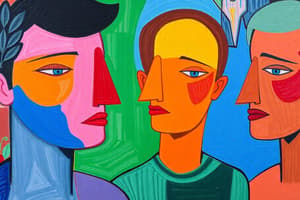Podcast
Questions and Answers
Increasing awareness of biases and prejudices can help individuals develop a critical understanding of their own beliefs and actions.
Increasing awareness of biases and prejudices can help individuals develop a critical understanding of their own beliefs and actions.
True (A)
Empathy building among diverse groups does not impact the reduction of negative stereotypes.
Empathy building among diverse groups does not impact the reduction of negative stereotypes.
False (B)
Policy interventions do not play a role in discouraging biases and prejudices.
Policy interventions do not play a role in discouraging biases and prejudices.
False (B)
Microinteractions have no effect on reinforcing or challenging existing biases and prejudices.
Microinteractions have no effect on reinforcing or challenging existing biases and prejudices.
Progress has been made in completely eradicating biases and prejudices.
Progress has been made in completely eradicating biases and prejudices.
Biases and prejudices have the same meaning.
Biases and prejudices have the same meaning.
Implicit biases occur above conscious awareness.
Implicit biases occur above conscious awareness.
Explicit biases are driven by personal beliefs and past experiences.
Explicit biases are driven by personal beliefs and past experiences.
Stereotyping involves the creation of complex images of social groups.
Stereotyping involves the creation of complex images of social groups.
Discrimination can result from both biases and prejudices.
Discrimination can result from both biases and prejudices.
Flashcards are hidden until you start studying
Study Notes
Biases and Prejudices
Understanding the Concepts
The terms "biases" and "prejudices" are often used interchangeably, but they represent distinct concepts. Biases refer to systematic errors in perception, judgment, or behavior due to factors such as prior knowledge, assumptions, or values. They may not necessarily reflect ill-will or negative attitudes towards others. On the other hand, prejudices involve preconceived opinions and judgments about others based on their membership in specific social groups, leading to unfair or discriminatory actions.
Types of Biases and Prejudices
There are various types of biases and prejudices, including:
-
Implicit Biases: These are biases that occur below conscious awareness, often resulting from societal stereotypes and cultural norms. Implicit biases can influence decision-making and behavior without the individual realizing it.
-
Explicit Biases: These are biases that are conscious and intentional, often driven by personal beliefs, emotions, or past experiences.
-
Stereotyping: This involves the creation and reinforcement of simplified, often negative, images of members of certain social groups. Stereotypes can fuel both implicit and explicit biases and prejudices.
-
Discrimination: This refers to unfair or unequal treatment of individuals or groups based on their membership in certain social categories, such as race, gender, religion, or age. Discrimination can result from both biases and prejudices.
Reducing Biases and Prejudices
Reducing biases and prejudices is a complex and ongoing process. Several strategies have been suggested to promote change, including:
-
Education: Increasing awareness of the existence and impact of biases and prejudices can help individuals develop a critical understanding of their own beliefs and actions.
-
Empathy Building: Encouraging empathy and understanding among diverse groups can help break down barriers and reduce negative stereotypes.
-
Policy Interventions: Implementing policies that promote equality and non-discrimination can create a social environment that discourages biases and prejudices.
-
Microinteractions: Small, daily interactions can either reinforce or challenge existing biases and prejudices. Intentional acts of kindness and respect towards individuals from marginalized groups can help reduce negative associations.
While progress has been made in reducing some forms of biases and prejudices, there is still much work to be done. Continued efforts to understand, acknowledge, and address these issues are crucial for fostering a more inclusive and equitable society.
Studying That Suits You
Use AI to generate personalized quizzes and flashcards to suit your learning preferences.




